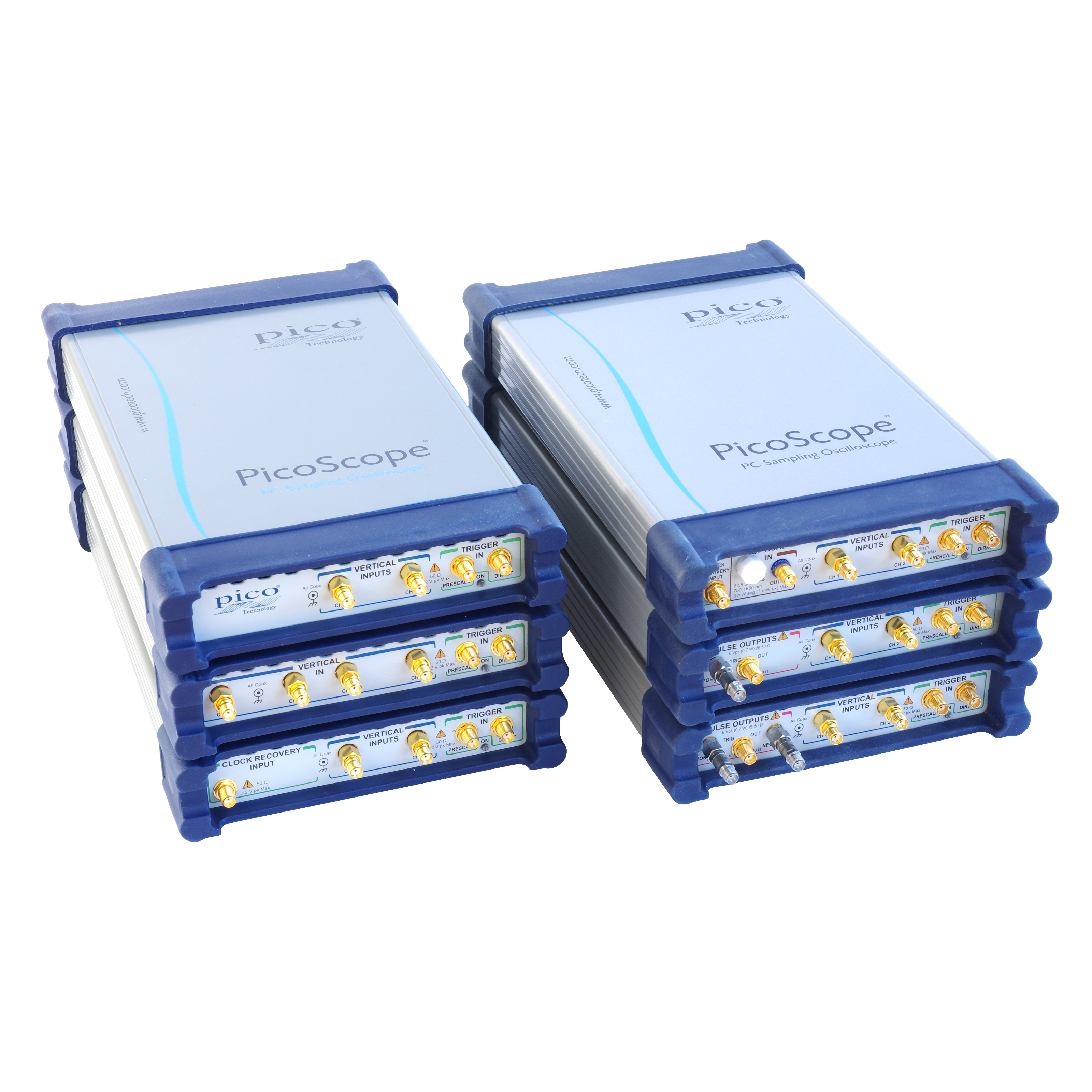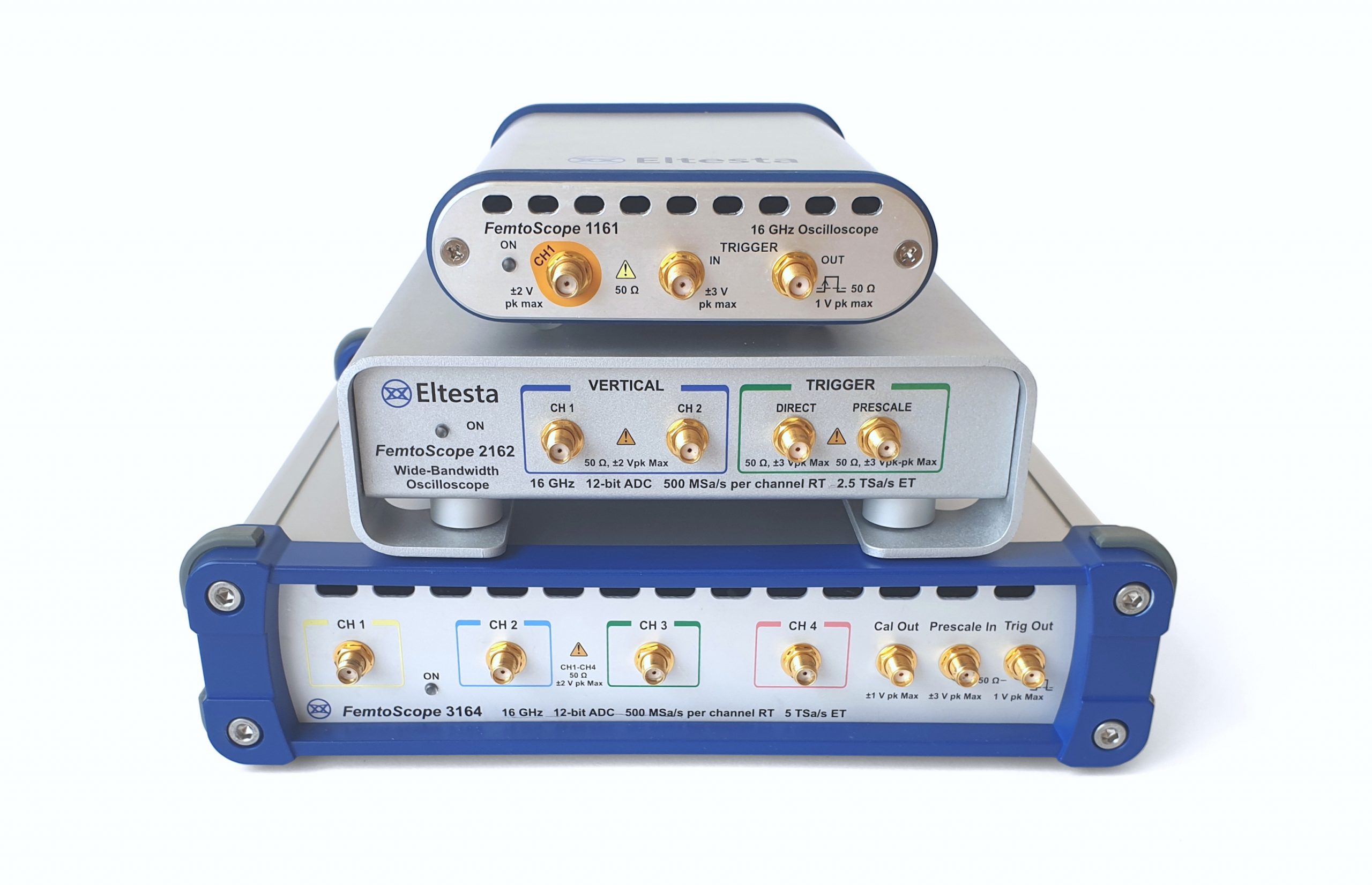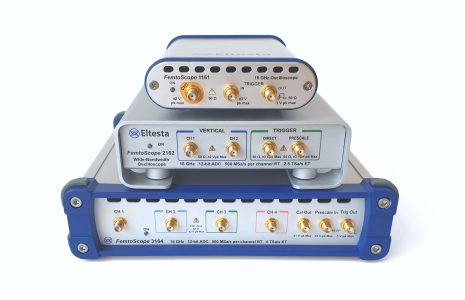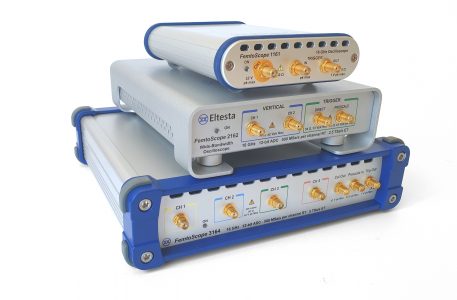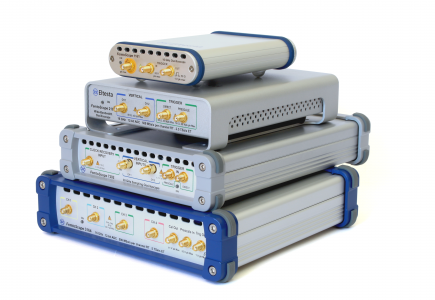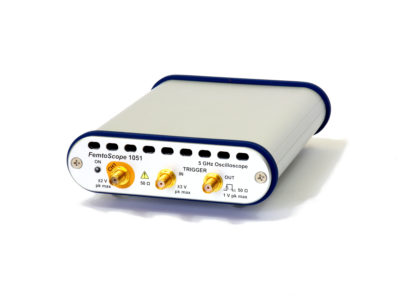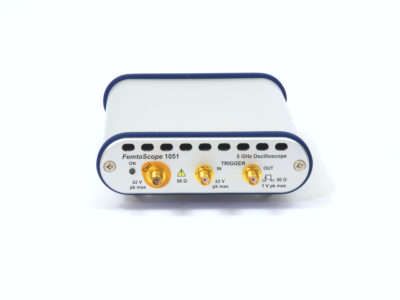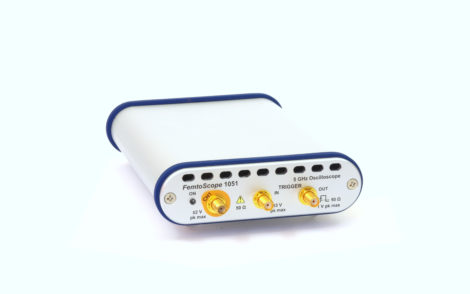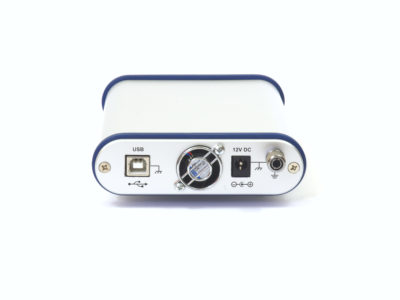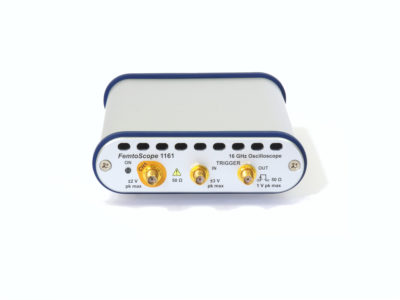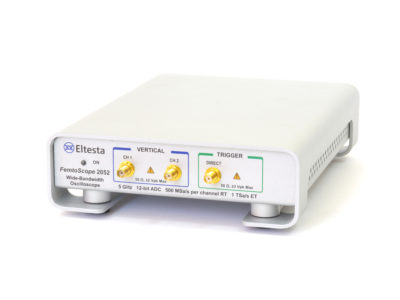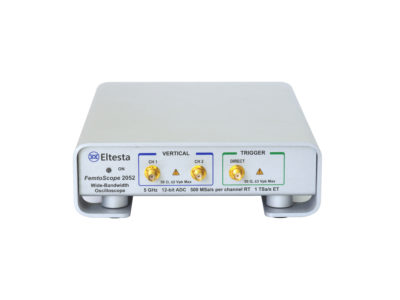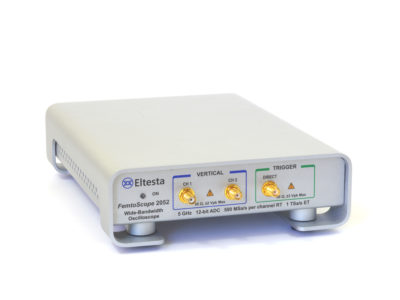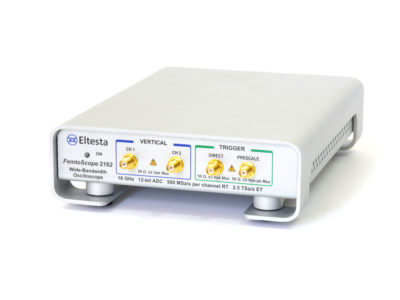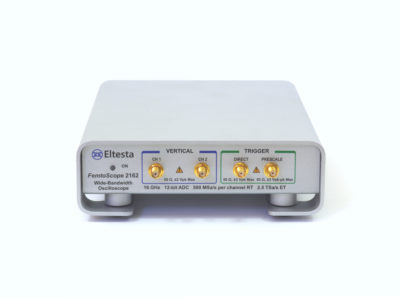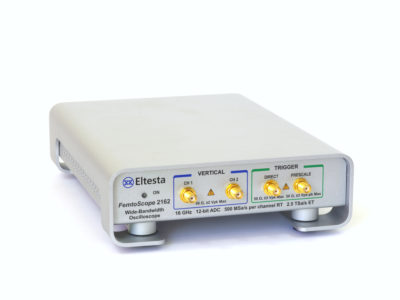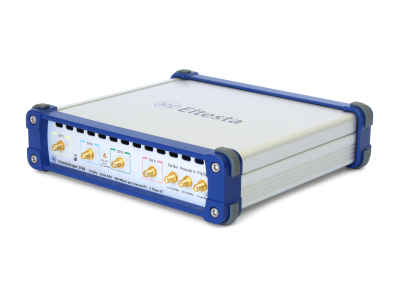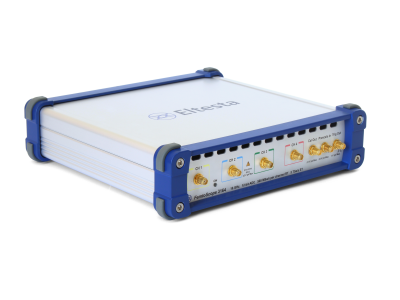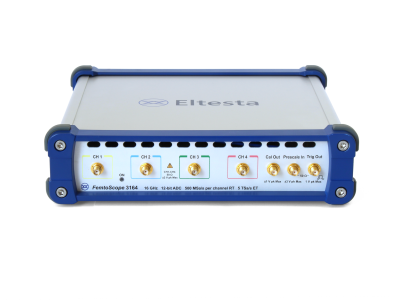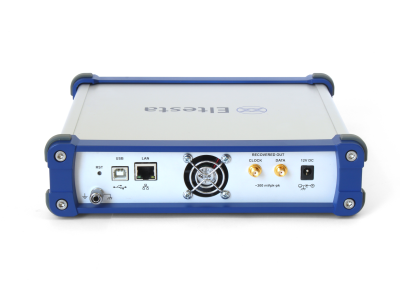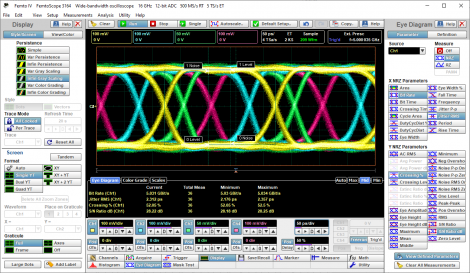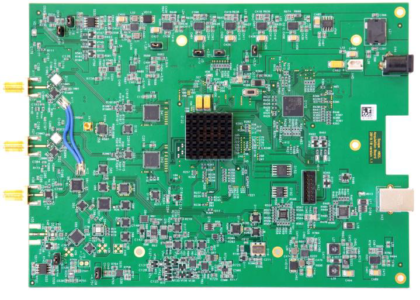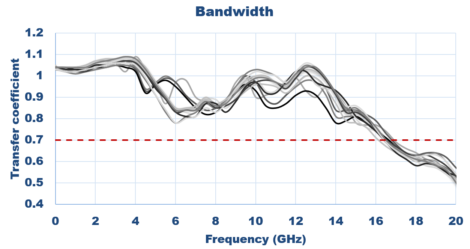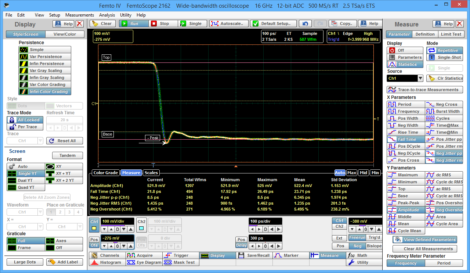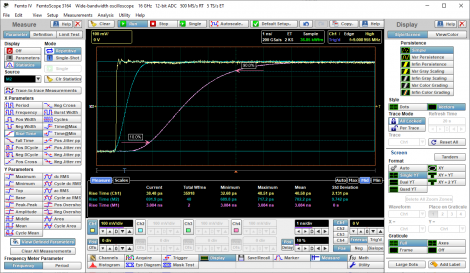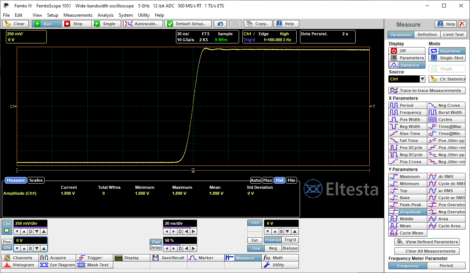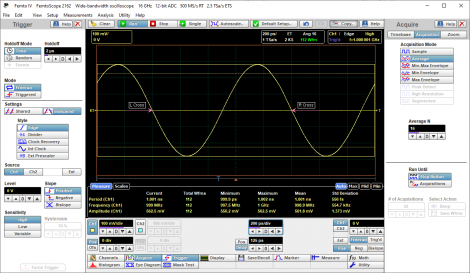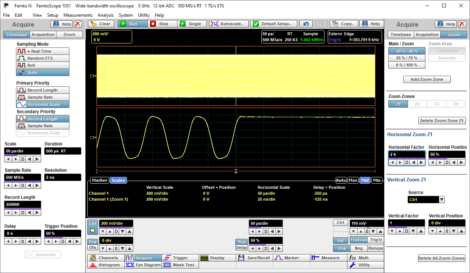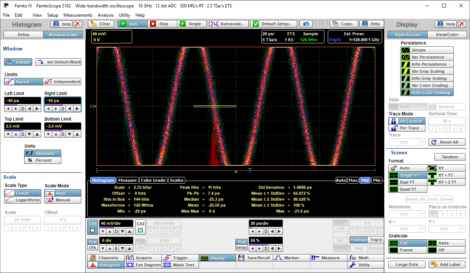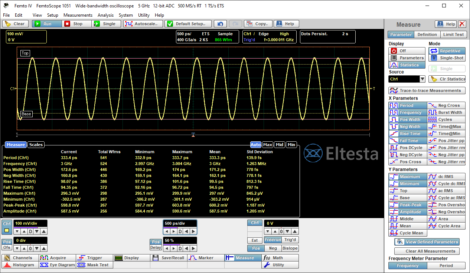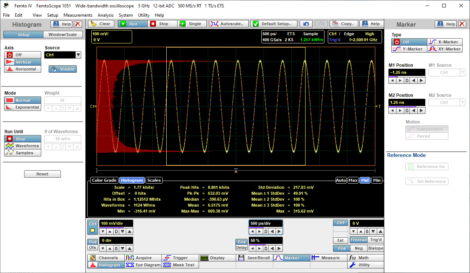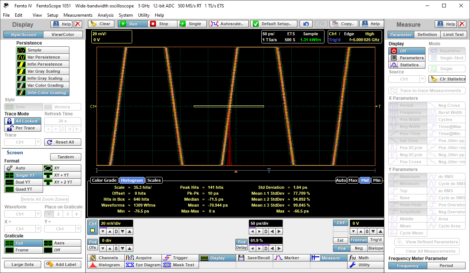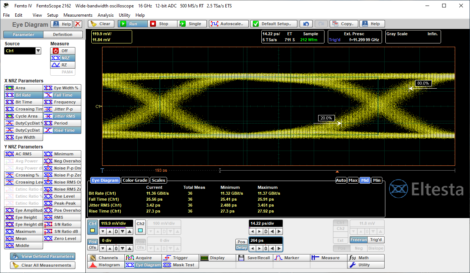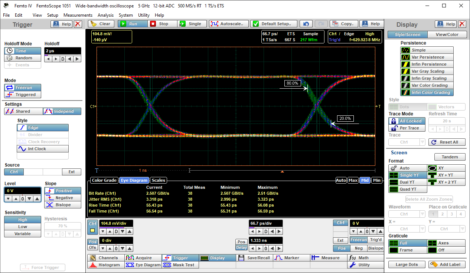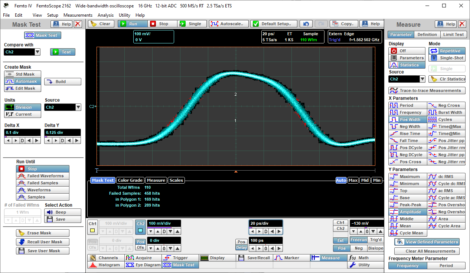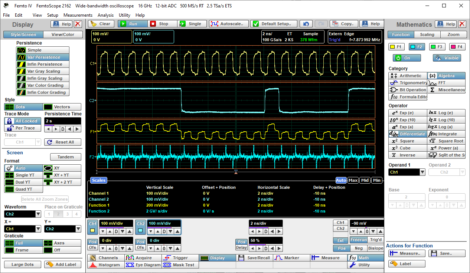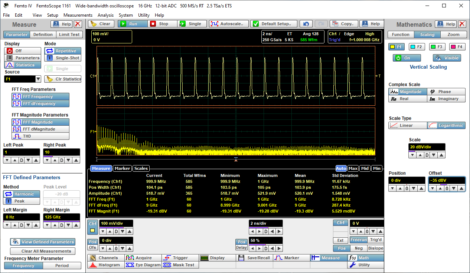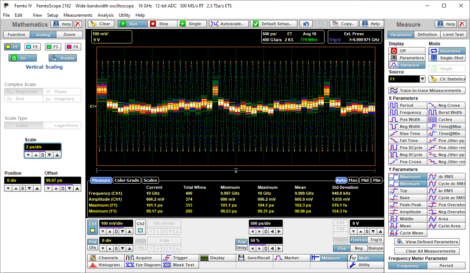| Mask test |
Acquired signals are tested for fit outside areas defined by up to eight polygons.
Any samples that fall within the polygon boundaries result in test failures.
Masks can be loaded from disk, or created automatically or manually.
|
| Mask creation |
You can create the following Mask: Standard predefined Mask, Automask, Mask saved on disk, Create new mask, Edit any mask. |
| Standard mask |
Standard predefined optical or standard electrical masks can be created. |
|
| SONET/SDH (10) |
OC1/STMO (51.84 Mb/s), OC3/STM1 (155.52 Mb/s), OC9/STM3 (466.56 Mb/s),
OC12/STM4 (622.08 Mb/s), OC18/STM6 (933.12 Mb/s), OC24/STM8 (1.2442 Gb/s),
OC48/STM16 (2.48832 Gb/s), FEC 2666 (2.6666 Gb/s)
|
|
|
|
OC192/STM64 (9.95328 Gb/s), FEC1066 (10.664 Gb/s) |
| Fibre Channel (31) |
FC133 Electrical (132.8 Mb/s), FC133 Optical (132.8 Mb/s), FC266 Electrical (265.6 Mb/s),
FC266 Optical (265.6 Mb/s), FC531 Electrical (531.35 Mb/s), FC531 Optical (531.35 Mb/s),
FC1063 Electrical (1.0625 Gb/s), FC1063 Optical (1.0625 Gb/s), FC1063 Optical PI Rev13 (1.0625 Gb/s),
FC1063E Abs Beta Rx.mask (1.0625 Gb/s), FC1063E Abs Beta Tx.mask (1.0625 Gb/s),
FC1063E Abs Delta Rx.mask (1.0625 Gb/s), FC1063E Abs Delta Tx.mask (1.0625 Gb/s),
FC1063E Abs Gamma Rx.mask (1.0625 Gb/s), FC1063E Abs Gamma Tx.mask (1.0625 Gb/s),
FC2125 Optical (2.1231 Gb/s), FC2125 Optical PI Rev13 (2.1231 Gb/s),
FC2125E Abs Beta Rx.mask (2.125 Gb/s), FC2125E Abs Beta Tx.mask (2.125 Gb/s),
FC2125E Abs Delta Rx.mask (2.125 Gb/s), FC2125E Abs Delta Tx.mask (2.125 Gb/s),
FC2125E Abs Gamma Rx.mask (2.125 Gb/s), FC2125E Abs Gamma Tx.mask (2.125 Gb/s).
|
|
|
|
FC4250 Optical PI Rev13 (4.25 Gb/s),
FC4250E Abs Beta Rx.mask (4.25 Gb/s),
FC4250E Abs Beta Tx.mask (4.25 Gb/s),
FC4250E Abs Delta Rx.mask (4.25 Gb/s),
FC4250E Abs Delta Tx.mask (4.25 Gb/s),
FC4250E Abs Gamma Rx.mask (4.25 Gb/s),
FC4250E Abs Gamma Tx.mask (4.25 Gb/s)
|
| Ethernet (11) |
100BASE-BX10 (125 Mb/s), 100BASE-BX/LX10 (125 Mb/s),
1.25 Gb/s 1000Base-CX Absolute TP2 (1.25 Gb/s), 1.25 Gb/s 1000Base-CX Absolute TP3 (1.25 Gb/s),
GB Ethernet (1.25 Gb/s), 2XGB Ethernet (2.5 Gb/s), 3.125 Gb/s 10GBase-CX4 Absolute TP2 (3.125 Gb/s).
|
|
|
|
10Gb Ethernet (9.953 Gb/s),
10GbE 9.953 (9.953 Gb/s),
10Gb Ethernet (10.3125 Gb/s),
10GbE 10.3125 (10.3125 Gb/s).
|
| Infiniband (16) |
2.5G InfiniBand Cable mask (2.5 Gb/s), 2.5G InfiniBand Driver Test Point 1 (2.5 Gb/s),
2.5G InfiniBand Driver Test Point 10 (2.5 Gb/s), 2.5G InfiniBand Driver Test Point 2 (2.5 Gb/s),
2.5G InfiniBand Driver Test Point 3 (2.5 Gb/s), 2.5G InfiniBand Driver Test Point 4 (2.5 Gb/s),
2.5G InfiniBand Driver Test Point 5 (2.5 Gb/s), 2.5G InfiniBand Driver Test Point 6 (2.5 Gb/s),
2.5G InfiniBand Driver Test Point 7 (2.5 Gb/s), 2.5G InfiniBand Driver Test Point 8 (2.5 Gb/s),
2.5G InfiniBand Driver Test Point 9 (2.5 Gb/s), 2.5G InfiniBand Receiver mask (2.5 Gb/s), InfiniBand (2.5 Gb/s).
|
|
|
|
5.0G InfiniBand Driver Test Point 1 (5 Gb/s),
5.0G InfiniBand Driver Test Point 6 (5 Gb/s),
5.0G InfiniBand Transmitter Pins (5 Gb/s)
|
| XAUI (4) |
3.125 Gb/s XAUI Far End (3.125 Gb/s), 3.125 Gb/s XAUI Far End (3.125 Gb/s),
XAUI-E Far (3.125 Gb/s),
XAUI-E Near (3.125 Gb/s)
|
| ITU G.703 (14) |
DS1, 100 Ω twisted pair (1.544 Mb/s), 2 Mb 120, 120 Ω twisted pair (2.048 Mb/s),
2 Mb 75, 75 Ω coax (2.048 Mb/s), DS2 110, 110 Ω twisted pair (6.312 Mb/s),
DS2 75, 75 Ω coax (6.312 Mb/s), 8 Mb, 75 Ω coax (8.448 Mb/s), 34 Mb, 75 Ω coax (34.368 Mb/s),
DS3, 75 Ω coax (44.736 Mb/s), 140 Mb 0, 75 Ω coax (139.264 Mb/s), 140 Mb 1, 75 Ω coax (139.264 Mb/s),
140 Mb 1 Inv, 75 Ω coax (139.264 Mb/s), 155 Mb 0, 75 Ω coax (155.520 Mb/s),
155 Mb 1, 75 Ω coax (155.520 Mb/s), 155 Mb 1 Inv, 75 Ω coax (155.520 Mb/s).
|
| ANSI T1/102 (7) |
DS1, 100 Ω twisted pair, (1.544 Mb/s), DS1C, 100 Ω
twisted pair, (3.152 Mb/s), DS2,
110 Ω twisted pair, (6.312 Mb/s),
DS3, 75 Ω coax, (44.736 Mb/s), STS1 Eye, 75 Ω coax, (51.84 Mb/s),
STS1 Pulse, 75 Ω coax, (51.84 Mb/s), STS3, 75 Ω coax, (155.520 Mb/s)
|
| RapidIO (9) |
RapidIO Serial Level 1, 1.25G Rx (1.25 Gb/s), RapidIO Serial Level 1, 1.25G Tx LR (1.25 Gb/s),
RapidIO Serial Level 1, 1.25G Tx SR (1.25 Gb/s), RapidIO Serial Level 1, 2.5G Rx (2.5 Gb/s),
RapidIO Serial Level 1, 2.5G Tx LR (2.5 Gb/s), RapidIO Serial Level 1, 2.5G Tx SR (2.5 Gb/s),
RapidIO Serial Level 1, 3.125G Rx (3.125 Gb/s), RapidIO Serial Level 1, 3.125G Tx LR (3.125 Gb/s),
RapidIO Serial Level 1, 3.125G Tx SR (3.125Gb/s)
|
| PCI Express (41) |
R1.0a 2.5G Add-in Card Transmitter Non-Transition bit mask (2.5 Gb/s),
R1.0a 2.5G Add-in Card Transmitter Transition bit mask (2.5 Gb/s),
R1.0a 2.5G Exp.Card Host Non-Transition bit mask (2.5 Gb/s),
R1.0a 2.5G Exp.Card Host Transition bit mask (2.5 Gb/s),
R1.0a 2.5G Exp.Card Module Non-Transition bit mask (2.5 Gb/s),
R1.0a 2.5G Exp.Card Module Transition bit mask (2.5 Gb/s),
R1.0a 2.5G Exp.Card Transmitter Non-Transition bit mask (2.5 Gb/s),
R1.0a 2.5G Exp.Card Transmitter Transition bit mask (2.5 Gb/s),
R1.1 2.5G Add-in Card Transmitter Non-Transition bit mask (2.5 Gb/s),
R1.1 2.5G Add-in Card Transmitter Transition bit mask (2.5 Gb/s),
R1.1 2.5G Cable Receiver End Non-Transition bit mask (2.5 Gb/s),
R1.1 2.5G Cable Receiver End Transition bit mask (2.5 Gb/s),
R1.1 2.5G Cable Transmitter End Non-Transition bit mask (2.5 Gb/s),
R1.1 2.5G Cable Transmitter End Transition bit mask (2.5 Gb/s),
R1.1 2.5G Express Module System Non-Transition bit mask (2.5 Gb/s),
R1.1 2.5G Express Module System Transition bit mask (2.5 Gb/s),
R1.1 2.5G Express Module Transmitter Path Non-Transition bit mask (2.5 Gb/s),
R1.1 2.5G Express Module Transmitter Path Transition bit mask (2.5 Gb/s),
R1.1 2.5G Receiver mask (2.5 Gb/s),
R1.1 2.5G System Board Transmitter Non-Transition bit mask (2.5 Gb/s),
R1.1 2.5G System Board Transmitter Transition bit mask (2.5 Gb/s),
R1.1 2.5G Transmitter Non-Transition bit mask (2.5 Gb/s),
R1.1 2.5G Transmitter Transition bit mask (2.5 Gb/s)
|
|
|
|
R2.0 5.0G Add-in Card 35 dB Transmitter Non-Transition bit mask (5 Gb/s),
R2.0 5.0G Add-in Card 60 dB Transmitter Non-Transition bit mask (5 Gb/s),
2.0 5.0G Add-in Card 35 dB Transmitter Transition bit mask (5 Gb/s),
R2.0 5.0G Add-in Card 60 dB Transmitter Transition bit mask (5 Gb/s),
R2.0 5.0G Mobile Transmitter mask (5 Gb/s),
R2.0 5.0G Receiver mask (5 Gb/s),
R2.0 5.0G System Board Transmitter Non-Transition bit
mask (5 Gb/s),
R2.0 5.0G System Board Transmitter Transition bit mask (5 Gb/s),
R2.0 5.0G Transmitter Non-Transition bit mask (5 Gb/s),
R2.0 5.0G Transmitter Transition bit mask (5 Gb/s).
R2.1 5.0G Transmitter Non-Transition bit mask (5 Gb/s),
R2.1 5.0G Transmitter Transition bit mask (5 Gb/s)
|
| Serial ATA (24) |
Ext Length, 1.5G 250 Cycle, Rx Mask (1.5 Gb/s), Ext Length, 1.5G 250 Cycle, Tx Mask (1.5 Gb/s),
Ext Length, 1.5G 5 Cycle, Rx Mask (1.5 Gb/s), Ext Length, 1.5G 5 Cycle, Tx Mask (1.5 Gb/s),
Gen1, 1.5G 250 Cycle, Rx Mask (1.5 Gb/s), Gen1, 1.5G 250 Cycle, Tx Mask (1.5 Gb/s),
Gen1, 1.5G 5 Cycle, Rx Mask (1.5 Gb/s), Gen1, 1.5G 5 Cycle, Tx Mask (1.5 Gb/s),
Gen1m, 1.5G 250 Cycle, Rx Mask (1.5 Gb/s), Gen1m, 1.5G 250 Cycle, Tx Mask (1.5 Gb/s),
Gen1m, 1.5G 5 Cycle, Rx Mask (1.5 Gb/s), Gen1m, 1.5G 5 Cycle, Tx Mask (1.5 Gb/s),
Ext Length, 3.0G 250 Cycle, Rx Mask (3 Gb/s), Ext Length, 3.0G 250 Cycle, Tx Mask (3 Gb/s),
Ext Length, 3.0G 5 Cycle, Rx Mask (3 Gb/s), Ext Length, 3.0G 5 Cycle, Tx Mask (3 Gb/s),
Gen1, 3.0G 250 Cycle, Rx Mask (3 Gb/s), Gen1, 3.0G 250 Cycle, Tx Mask (3 Gb/s),
Gen1, 3.0G 5 Cycle, Rx Mask (3 Gb/s), Gen1, 3.0G 5 Cycle, Tx Mask (3 Gb/s),
Gen1m, 3.0G 250 Cycle, Rx Mask (3 Gb/s), Gen1m, 3.0G 250 Cycle, Tx Mask (3 Gb/s),
Gen1m, 3.0G 5 Cycle, Rx Mask (3 Gb/s), Gen1m, 3.0G 5 Cycle, Tx Mask (3 Gb/s).
|
| Mask margin |
Available for industry-standard mask testing |
| Automask creation |
Masks are created automatically for single-valued voltage signals. Automask specifies both delta X and delta Y tolerances.
The failure actions are identical to those of limit testing.
|
| Data collected during test |
Total number of waveforms examined, number of failed samples, number of hits within each polygon boundary |
